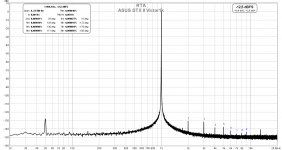Very good question.
What is the amplitude of the fundamental frequency in this measurement? We can't see the full graph.
I didn' dare to ask... 😎
Sorry, there was still the attenuator in during the measurement. I will measure again this week.
Sorry, there was still the attenuator in during the measurement. I will measure again this week.
Without atting a Notch you will see the ADC THD...😀
Hp
- yes: turn on an averaging. 🙂I need a better ADC. As you know, you are never satisfied yourself. Any recommendations?
Last edited:
This ADC isn't the best ADC, but best ones are not as much better, as we want. As I see, he have got a good lucky one. I have about the same result with Xonar Essence ST.Xonar DX uses CS5361 ... According to the specification, this is not the best ADC chip.
Xonar Essence has the CS5381. The same as my Xonar D2 has. This chip is one of the best.This ADC isn't the best ADC, but best ones are not as much better, as we want. As I see, he have got a good lucky one. I have about the same result with Xonar Essence ST.
What the residual harmonics you can measure with your Essence? What is the input signal level (dBFs) in the best linearity region of your card (when the residual harmonics become invisible)?
- yes: turn on an averaging. 🙂
Averaging won't change a thing, unless it's synchronized and is performed in either vector FFT or time domain. Then it will reduce noise only, like 20-30dB of noise reduction.
Any averaging that reduces harmonics is faulty 🙂
CS5381 in my ASUS STX II, oscillator Victor1k;
as Victor wrote, -130dB
as Victor wrote, -130dB
Attachments
Last edited:
CS5381 in my ASUS STX II, oscillator Victor1k;
as Victor wrote, -130dB
-135dB ;-)
It is difficult to measure when the residual harmonics are visible. I always use the input levels when the residuals become invisible.
Hi Folks,
reading the last few posts has made me start to question the capability of my sound card - M-audio Audiophile 192. Could anyone kindly give me some feedback on how this card stands up to the newer generation like the Asus cards that Viktor and other have mentioned? I only use it for measurement purposes but find that even with a differential input and output, it is still succeptable to hum pick up. How do the likes of the Asus D2 cope in this area?
Thanks and regards
Mike
reading the last few posts has made me start to question the capability of my sound card - M-audio Audiophile 192. Could anyone kindly give me some feedback on how this card stands up to the newer generation like the Asus cards that Viktor and other have mentioned? I only use it for measurement purposes but find that even with a differential input and output, it is still succeptable to hum pick up. How do the likes of the Asus D2 cope in this area?
Thanks and regards
Mike
-135dB ;-)
From the numbers it looks more like -126.7dB.
Not bad, but to do better you may need the AK5394A 😉
The highest harmonic is at -130dB but the fundamental is at +5dB. Hence my mention of -135dB ;-)
Jan
Jan
Actually the fundamental seems to be at 0dB. Due to the text it is not easy to tell from the figure.
And the second harmonic is at around -130dB. This fits with the 0.000031% = -130.2dB. The THD is stated as 0.000046% = -126.745dB.
And the second harmonic is at around -130dB. This fits with the 0.000031% = -130.2dB. The THD is stated as 0.000046% = -126.745dB.
Seems that the M-audio Audiophile 192 uses AKM 5385A. It is the same as in my E-MU 0202. The E-MU can do around -125dB at mid frequencies, and slightly worse at high. You can choose the best channel - may be a little difference. Also needs to discover the best level for the input signal. If the hum and noise is a problem, then may needs to modify the schematic at the ADC chip input, but this may be not so easy...Hi Folks,
reading the last few posts has made me start to question the capability of my sound card - M-audio Audiophile 192. Could anyone kindly give me some feedback on how this card stands up to the newer generation like the Asus cards that Viktor and other have mentioned? I only use it for measurement purposes but find that even with a differential input and output, it is still succeptable to hum pick up. How do the likes of the Asus D2 cope in this area?
Thanks and regards
Mike
Actually the fundamental seems to be at 0dB. Due to the text it is not easy to tell from the figure.
And the second harmonic is at around -130dB. This fits with the 0.000031% = -130.2dB. The THD is stated as 0.000046% = -126.745dB.
I see the fundamental spiking through the text (black spike) at +5. The 2nd is at -130 so the difference between fund and 2nd is -135 in my view, but I'm not going to war over it.
Jan
I see the fundamental spiking through the text (black spike) at +5. The 2nd is at -130 so the difference between fund and 2nd is -135 in my view, but I'm not going to war over it.
Jan
yes, i see that also from dbC scale. BUT, the data says -12.5 dbFS
-RNM
- Home
- Design & Build
- Equipment & Tools
- Low-distortion Audio-range Oscillator
